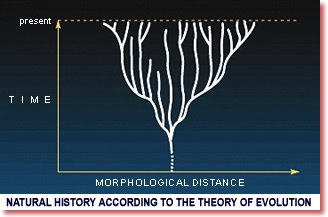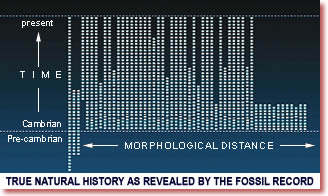Cambrian Explosion
Complex life forms appear suddenly in the Cambrian explosion, with no ancestral fossils.
The Cambrian explosion was the seemingly sudden appearance of a variety of complex animals about 540 million years ago (Mya), but it was not the origin of complex life. Evidence of multicellular life from about 590 and 560 Mya appears in the Doushantuo Formation in China (Chen et al. 2000, 2004), and diverse fossil forms occurred before 555 Mya (Martin et al. 2000). (The Cambrian began 543 Mya., and the Cambrian explosion is considered by many to start with the first trilobites, about 530 Mya.) Testate amoebae are known from about 750 Mya (Porter and Knoll 2000). There are tracelike fossils more than 1,200 Mya in the Stirling Range Formation of Australia (Rasmussen et al. 2002). Eukaryotes (which have relatively complex cells) may have arisen 2,700 Mya, according to fossil chemical evidence (Brocks et al. 1999). Fossil microorganisms have been found from 3,465 Mya (Schopf 1993). There is isotopic evidence of sulfur-reducing bacteria from 3,470 Mya (Shen et al. 2001) and possible evidence of microbial etching of volcanic glass from 3,480 Mya (Furnes et al. 2004).
There are transitional fossils within the Cambrian explosion fossils. For example, there are lobopods (basically worms with legs) which are intermediate between arthropods and worms (Conway Morris 1998).
Only some phyla appear in the Cambrian explosion. In particular, all plants postdate the Cambrian, and flowering plants, by far the dominant form of land life today, only appeared about 140 Mya (Brown 1999).
Even among animals, not all types appear in the Cambrian. Cnidarians, sponges, and probably other phyla appeared before the Cambrian. Molecular evidence shows that at least six animal phyla are Precambrian (Wang et al. 1999). Bryozoans appear first in the Ordovician. Many other soft-bodied phyla do not appear in the fossil record until much later. Although many new animal forms appeared during the Cambrian, not all did. According to one reference (Collins 1994), eleven of thirty-two metazoan phyla appear during the Cambrian, one appears Precambrian, eight after the Cambrian, and twelve have no fossil record.
And that just considers phyla. Almost none of the animal groups that people think of as groups, such as mammals, reptiles, birds, insects, and spiders, appeared in the Cambrian. The fish that appeared in the Cambrian was unlike any fish alive today.
The length of the Cambrian explosion is ambiguous and uncertain, but five to ten million years is a reasonable estimate; some say the explosion spans forty million years or more, starting about 553 million years ago. Even the shortest estimate of five million years is hardly sudden.
There are some plausible explanations for why diversification may have been relatively sudden:
The evolution of active predators in the late Precambrian likely spurred the coevolution of hard parts on other animals. These hard parts fossilize much more easily than the previous soft-bodied animals, leading to many more fossils but not necessarily more animals.
Early complex animals may have been nearly microscopic. Apparent fossil animals smaller than 0.2 mm have been found in the Doushantuo Formation, China, forty to fifty-five million years before the Cambrian (Chen et al. 2004). Much of the early evolution could have simply been too small to see.
The earth was just coming out of a global ice age at the beginning of the Cambrian (Hoffman 1998; Kerr 2000). A "snowball earth" before the Cambrian explosion may have hindered development of complexity or kept populations down so that fossils would be too rare to expect to find today. The more favorable environment after the snowball earth would have opened new niches for life to evolve into.
Hox genes, which control much of an animal's basic body plan, were likely first evolving around that time. Development of these genes might have just then allowed the raw materials for body plans to diversify (Carroll 1997).
Atmospheric oxygen may have increased at the start of the Cambrian (Canfield and Teske 1996; Logan et al. 1995; Thomas 1997).
Planktonic grazers began producing fecal pellets that fell to the bottom of the ocean rapidly, profoundly changing the ocean state, especially its oxygenation (Logan et al. 1995).
Unusual amounts of phosphate were deposited in shallow seas at the start of the Cambrian (Cook and Shergold 1986; Lipps and Signor 1992).
Cambrian life was still unlike almost everything alive today. Using number of cell types as a measure of complexity, we see that complexity has been increasing more or less constantly since the beginning of the Cambrian (Valentine et al. 1994).
Major radiations of life forms have occurred at other times, too. One of the most extensive diversifications of life occurred in the Ordovician, for example (Miller 1997).



